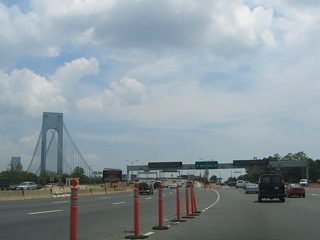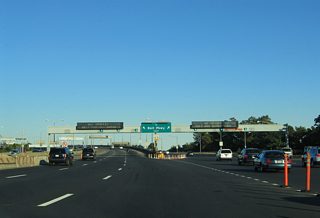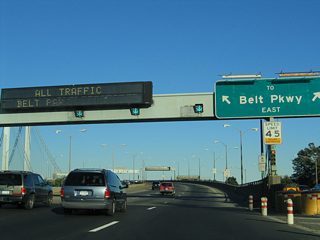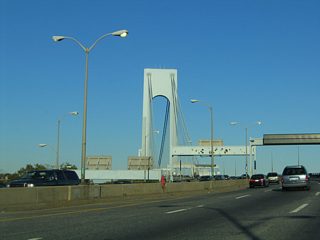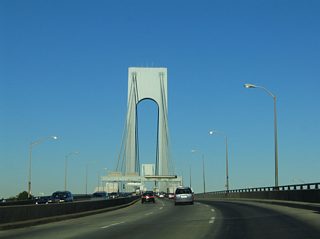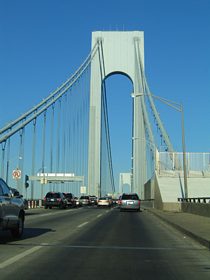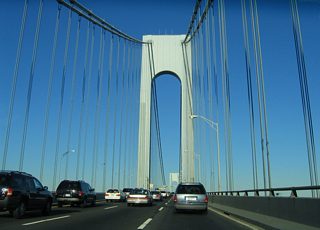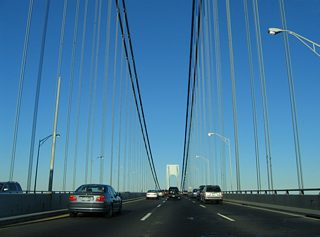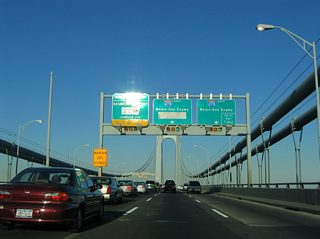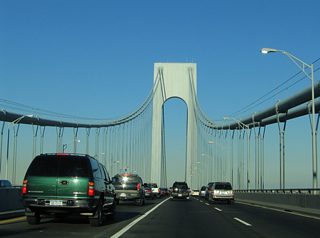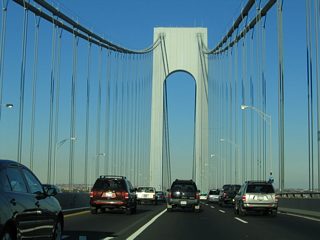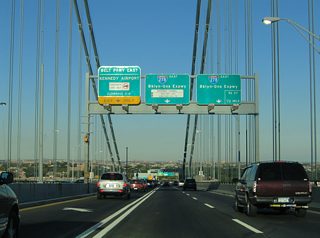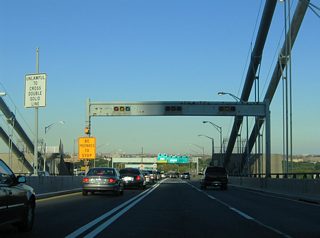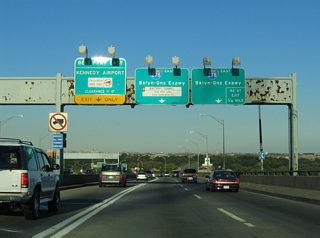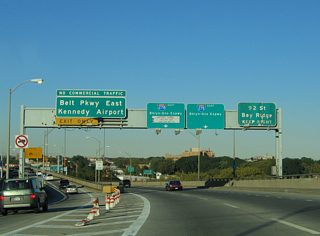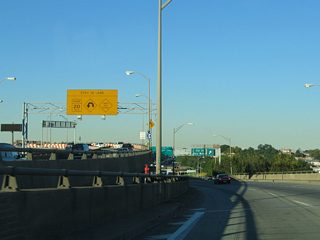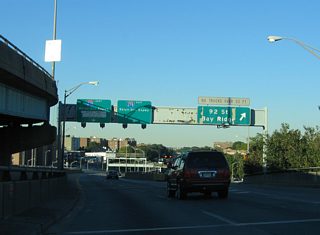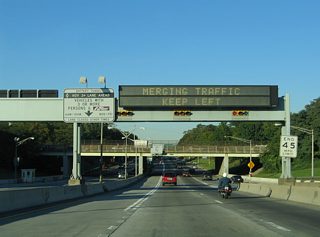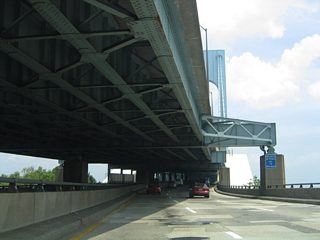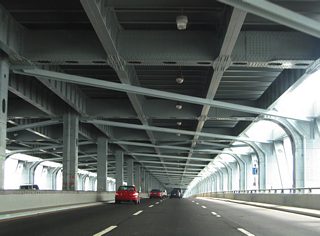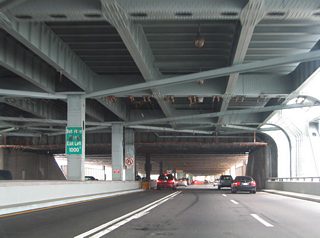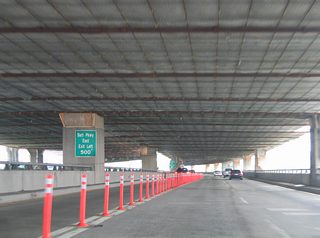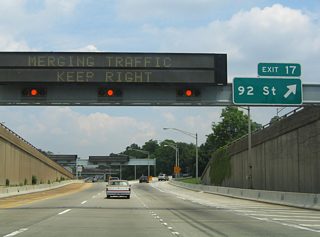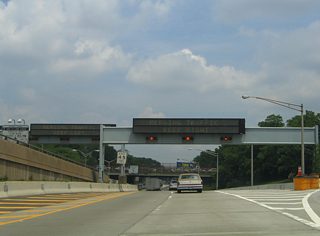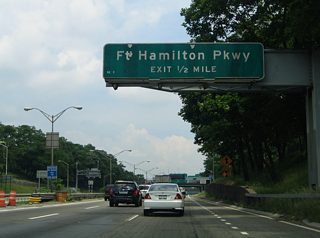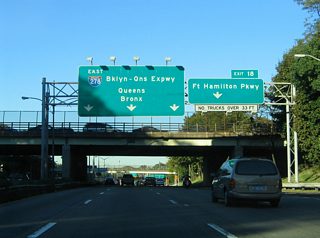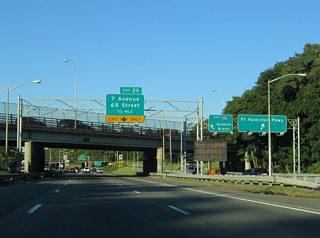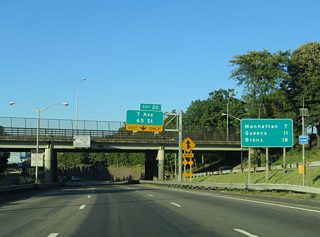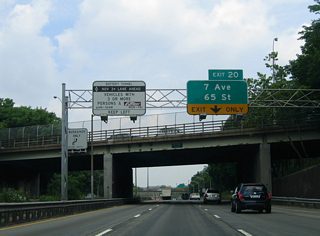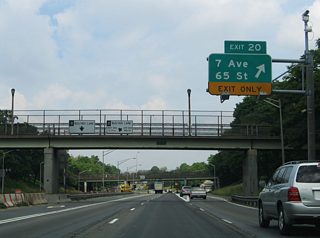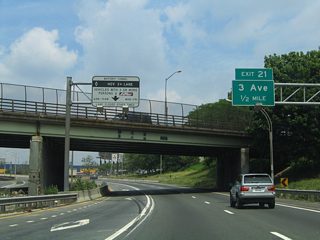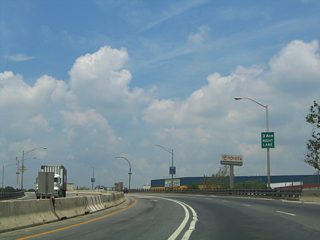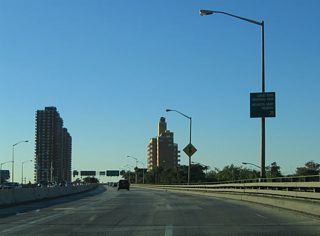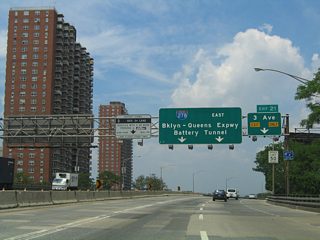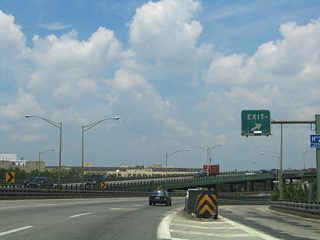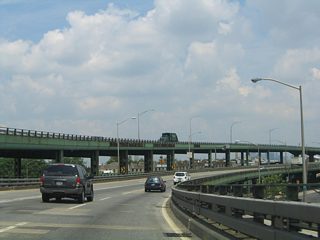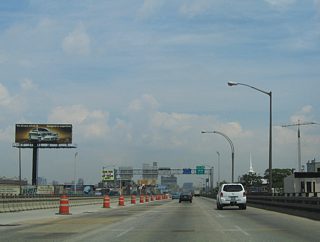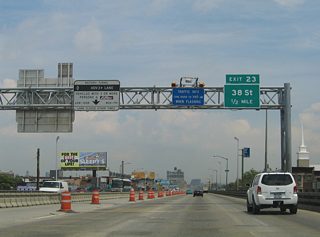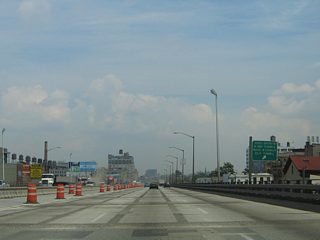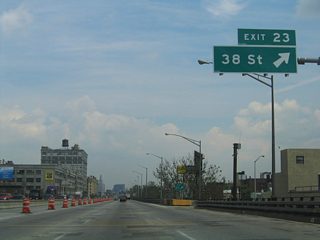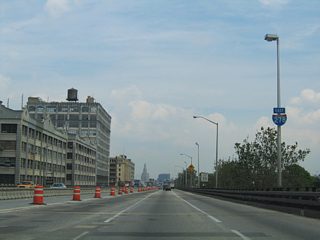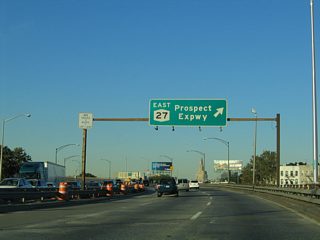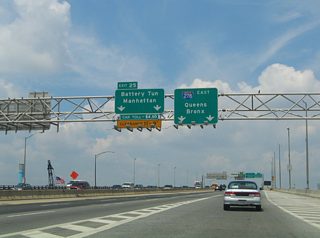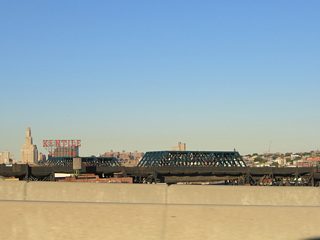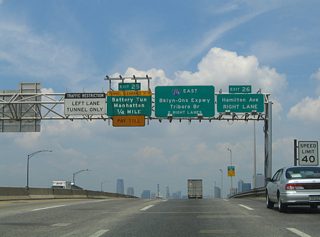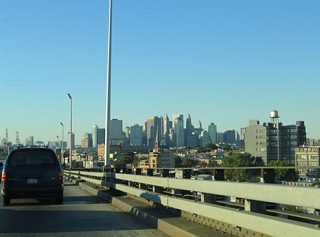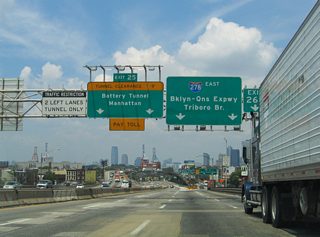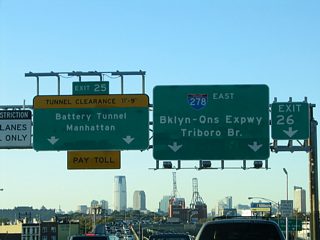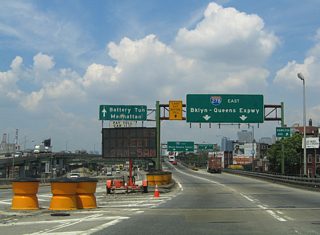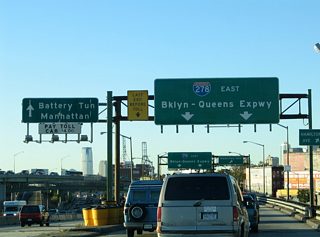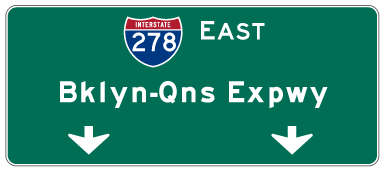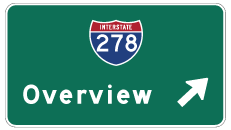|
| Interstate 278 (Staten Island Expressway) eastbound enters the Verrazzano-Narrows Bridge. The suspension bridge carries two decks of traffic, each carrying six lanes. A guide sign indicates that access to the Belt Parkway is provided by both levels of Interstate 278. The Verrazzano-Narrows Bridge held the title as the largest suspension bridge in the world until 1981, when England's Humber Bridge was completed. As of 2012, it is now the eighth in the size hierarchy of bridges. The span is named for Giovanni di Verrazano, the Italian explorer who discovered New York Harbor in 1592.2 06/13/05, 10/03/04 |
|
| The Verrazano-Narrows Bridge spans The Narrows between Lower and Upper New York Bay. The twelve lane double-decked bridge joins Staten Island with Brooklyn and the Gowanis Expressway. 10/03/04 |
|
| The Verrazzano-Narrows Bridge opened to traffic on November 21, 1964 to surpass the Golden Gate Bridge as the largest suspension bridge in the world. Designed by Othmar Amman, architect of the Bayonne Bridge, the Verrazzano-Narrows Bridge incorporates the curvature of the earth and seasonal expansions which result in a 12 foot difference in the bridge deck height from Summer to Winter.1 10/03/04 |
|
| The first of two sign bridges posted on the upper deck of the Verrazzano-Narrows Bridge for the Belt Parkway interchange in Brooklyn. The Belt Parkway system encircles Brooklyn and Queens between the Gowanus Expressway at Borough Park and the Whitestone Expressway at Malba. The parkway hugs the shoreline from Interstate 278 southeast to Coney Island. 10/03/04 |
|
| Views of the eastern tower of the Verrazzano-Narrows Bridge. The suspension bridge and approaches tally 13,700 feet in length with a 228 foot channel height at mid-span. The 693 foot towers support the bridge that was built at a cost of $320.1 million. The lower deck of the span opened to traffic on June 28, 1969, six years ahead of schedule.2 10/03/04 |
|
| The upper deck of the Verrazzano-Narrows Bridge partitions into two through lanes for I-278 east (Gowanus Expressway) and one lane for the Belt Parkway. Traffic to the 92nd Street is directed to the right for the exit from the Gowanus Expressway north. Restricted to passenger vehicles only, the Belt Parkway is signed as the preferred route to John F. Kennedy International Airport (JFK). 10/03/04 |
|
| Descending into the Borough of Queens on Interstate 278 eastbound. Although signs refer to Interstate 278 as the Brooklyn-Queens Expressway (BQE) here, the Interstate first travels the Gowanus Expressway. The Gowanus Expressway entails Interstate 278 between the Verrazzano-Narrows Bridge and the Brooklyn Battery Tunnel (Interstate 478). 10/03/04 |
|
| Traffic partitions between Interstate 278 (Gowanus Expressway) east and the Belt Parkway. The limited amount of space available for the ramp connections between the two freeways mandates a tight loop ramp that doubles south from the Verrazzano-Narrows Bridge to the Belt Parkway itself. Access is only available to the Belt Parkway eastbound toward Coney Island, Sheepshead Bay, and JFK Airport. 10/03/04 |
|
| The Belt Parkway off-ramp u-turns over the westbound lanes of Interstate 278 through adjacent John J. Carty Park, John Paul Jones Park, and Fort Hamilton. Meanwhile on Interstate 278 the 92nd Street off-ramp departs ahead. 10/03/04 |
|
| Interstate 278 (Gowanus Expressway) eastbound at 92nd Street between Bay Ridge and Dyker Heights. 92nd Street travels east-west between 4th and 7th Avenues north of Fort Hamilton. 10/03/04 |
|
| The Gowanus Expressway passes over 92nd Street as it widens to six lanes. Additionally a northbound HOV-3 lane was added for Interstate 278 eastbound during the 1990s. The High Occupancy Facility is open between Monday and Friday between 6 and 10 AM and closed at all other times. Traffic using the HOV lane defaults onto the Brooklyn Battery Tunnel approach for Lower Manhattan. All users of the facility must be EZ-Pass account holders as tolls collected for Interstate 478 from the roadway utilize an EZ-Pass lane.3 10/03/04 |
|
| The lower deck of Verrazzano-Narrows Bridge merges onto Interstate 278 eastbound at the 92nd Street overpass. The HOV-3 lane to the Brooklyn Battery Tunnel separates from traffic at the same location. Traffic from Staten Island bound for the HOV facility utilizes the upper deck of the suspension bridge. 10/03/04 |
|
| Moving underneath the upper level of Interstate 278 along the lower deck of the Verrazzano-Narrows Bridge. The lower deck has no shoulders and carries six overall lanes. 06/13/05 |
|
| Traveling eastbound between the two towers of the Verrazzano-Narrows Bridge along the lower level. 06/13/05 |
|
| Similar to the upper level, the left lane of the lower level defaults onto the Belt Parkway eastbound loop ramp. 06/13/05 |
|
| Belt Parkway splits from Interstate 278 near Bay Ridge to hug the shoreline of Upper New York Bay and The Narrows to Fort Hamilton. The limited access highway continues east from I-278 to Bath Beach and Coney Island. 06/13/05 |
|
| Ramps from the lower and upper level combine ahead of the 180 degree curve above John J. Carty Park. Parallel ramps split for Staten Island in this scene as well. 06/13/05 |
|
| Two lanes of the lower level emerge ahead of the Exit 17 off-ramp to 92nd Street. 92nd Street connects Interstate 278 (Gowanus Expressway) with 7th Avenue and Fort Hamilton nearby. 06/13/05 |
|
| Merging with the lanes from the Verrazzano-Narrows Bridge upper level from the lower level lanes. 06/13/05 |
|
| Next in line for Interstate 278 eastbound traffic is the Fort Hamilton Parkway off-ramp at Dyker Heights. Fort Hamilton Parkway emanates from 7th Avenue adjacent to the Gowanus Expressway and travels northward through Borough Park to Kensington and Prospect Park. 06/13/05 |
|
| Seven lanes of the Gowanus Expressway pass underneath the 86th Street over crossing, midway between the 92nd Street and Fort Hamilton Parkway interchanges. Traffic departing Exit 18 ahead briefly joins the on-ramp to Interstate 278 from Dahlgren Place and 86th Street. 10/03/04 |
|
| A look at the Fort Hamilton Parkway over crossing and the Exit 18 ramp split from the 86th Street on-ramp. Ahead is Exit 20 for 7th Avenue and 65th Street at Leif Ericson Park and Square. Interstate 278 curves westward alongside 65th Street from 7th Avenue to 3rd Avenue and the Belt Parkway. 10/03/04 |
|
| Interstate 278 eastbound distance sign for Manhattan (via Interstate 478), Queens (via the BQE), and Bronx (via the Triborough Bridge) posted at the 86th Street on-ramp at the 79th Street overpass. 10/03/04 |
|
| Interstate 278 eastbound traffic nears a second entry point onto the Brooklyn Battery Tunnel HOV-3 facility near the Bay Ridge Parkway over crossing. Exit 20 meanwhile departs the freeway within one quarter mile onto adjacent 7th Avenue northbound ahead of its intersection with 66th Street. Use 7th Avenue north or 65th Street for the Borough Park neighborhood of Brooklyn. 06/13/05 |
|
| Exit 20 leaves Interstate 278 eastbound for 7th Avenue and 65th Street. 65th Street continues east from the Gowanus Expressway through the New Utrecht section of Brooklyn to Avenue P. The surface street is discontinuous due to the Gowanus Expressway between 6th and 4th Avenues to the west. 06/13/05 |
|
| The HOV-3 facility returns to the Interstate 278 eastbound mainline affording drivers a second opportunity to access it for access to Lower Manhattan via Interstate 478 northbound. The Interstate 278 eastbound mainline is relegated to just two lanes as it turns northwest toward the Belt Parkway merge over 3rd Avenue. 06/13/05 |
|
| Interstate 278 elevates onto a six lane viaduct between 6th Avenue and the Belt Parkway interchange at 3rd Avenue. Traffic to Exit 21 (3rd Avenue) should remain in the right lane for the upcoming off-ramp.
Street lights in this scene were replaced by 2007. 06/13/05 |
|
| A small substandard sign directs motorists bound for Sunset Park Industrial Park and the Brooklyn Army Terminal onto the 3rd Avenue (Exit 21). The eastbound off-ramp descends onto the surface at the intersection of 3rd Avenue and 63rd Street.
This sign was retained when street lights were replaced by 2007. 10/03/04 |
|
| Gowanus Expressway curves northwestward to merge with the north end of the Belt Parkway beyond the Exit 21 ramp to 3rd Avenue. 3rd Avenue parallels the elevated freeway between 61st Street and the Prospect Expressway (NY 27). Use 3rd Avenue for the Sunset Park district of Brooklyn. 06/13/05 |
|
| Interstate 278 resumes a northward course as the Belt Parkway merges in from the southwest at Sunset Park. An overhead exit sign (replaced by 2007) directs Exit 20 traffic onto 3rd Avenue below. 06/13/05 |
|
| The westbound lanes of the Gowanus Expressway viaduct soar high above the city streets of Brooklyn below. The elevated roadway passes over the Belt Parkway ramps that join Interstate 278 from the inside lanes. 06/13/05 |
|
| Roadways of Interstate 278 combine to form a seven-lane viaduct. The left lane remains a dedicated HOV-3 facility northward to Interstate 478. 06/13/05 |
|
| Street light replacements were underway in 2004-05. 06/13/05 |
|
| The advent of additional traffic from Belt Parkway generally slows Interstate 278 eastbound along the viaduct preceding Exit 23 to 38th Street. 06/13/05 |
|
| Points of interest for Exit 23 include the South Brooklyn Marine Terminal and the Moore McCormack 23rd Street Terminal. 06/13/05 |
|
| Exit 23 leaves Interstate 278 (Gowanus Expressway) eastbound for 38th Street at 4th Avenue. The off-ramp turns perpendicularly from the viaduct directly onto 38th Street eastbound below at Sunset Park.
This sign was a replacement in 2005. 06/13/05 |
|
| Eastbound Interstate 278 reassurance shield posted after the 38th Street exit. 06/13/05 |
|
| Exit 24 carries drivers from I-278 onto NY 27 (Prospect Expressway) eastbound to the Kensington, Parkville, and Flatbush sections of Brooklyn. The Prospect Expressway represents the western extant of the east-west NY 27 from the Gowanus Expressway eastward to Ocean Parkway. The freeway spur from I-278 stems southeast to Church Avenue where it transitions into the at-grade Ocean Parkway. NY 27 leaves the freeway for Church Avenue east.
This overhead assembly was removed during the Gowanus Expressway Repair and Interim Deck Replacement Project undertaken between Summer 2008 and Winter 2011. 10/03/04 |
|
| Interstate 278 curves back to the northwest at the Exit 24 gore point for NY 27 east. The Prospect Expressway was planned in 1963 to continue south of its abrupt end at Church Avenue along the corridor of Ocean Parkway 4.2 miles to Shore Parkway (Belt Parkway) at Coney Island. A 1966 plan involved extending the freeway southeast along Flatbush Avenue to the Gil Hodges Memorial Bridge and Roxbury. Each respective plan involved completion by 1975.
Opposition to new expressway construction resulted from other ongoing projects and therefore both plans never came to fruition.4 06/13/05 |
|
| Interstate 278 ascends across Gowanus Canal between NY 27 (Prospect Expressway) and the Exit 25 directional interchange with the Brooklyn Battery Tunnel. The addition of traffic from the Prospect Expressway westbound expands Interstate 278 west to four lanes. 06/13/05 |
|
| A view to the east of the Interstate 278 Gowanus Expressway bridge reveals the 9th Street truss bridge and various high rises dotting the Brooklyn skyline. 10/03/04 |
|
| Triboro Bridge joins the Brooklyn-Queens Expressway distinction on Interstate 278 eastbound pull-through panels ahead of the split with Interstate 478 (Brooklyn Battery Tunnel) northbound. The Brooklyn Battery Tunnel provides four lanes of traffic between the Gowanus Expressway / BQE and Lower Manhattan at West Street (NY 9A). 06/13/05 |
|
| The Lower Manhattan skyline of New York sprawls across the northern horizon for Interstate 278 eastbound travelers. A small guide sign follows and advises motorists destined for Exit 26 and Hamilton Avenue to remain in the right lane for the upcoming off-ramp. Hamilton Avenue parallels the Gowanus Expressway between 9th Street and the Brooklyn Battery Tunnel approach. 10/03/04 |
|
| The left lanes of I-278 eastbound default to the Hugh L. Carey (Brooklyn Battery) Tunnel. Tolls are collected electronically in both directions for the four lane crossing of the East River. I-278 transitions onto the Brooklyn-Queens Expressway (BQE) from the Gowanus Expressway at Exits 25/26 (Hamilton Avenue). 06/13/05, 10/03/04 |
|
| The northbound beginning of unsigned Interstate 478 splits northwest from Interstate 278 (Gowanus Expressway) eastbound at Exit 25. Interstate 478 is a numbering convention first proposed for the Manhattan Bridge linking the BQE with the unconstructed Lower Manhattan Expressway (Interstate 78). A later use (1971) for the 478 designation was applied to the Westway proposal along the west side of Manhattan Island leading north from the Brooklyn Battery Tunnel. 06/13/05, 10/03/04 |
Page Updated 02-07-2012.
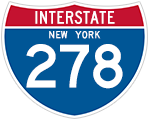
 East
East East - upper level
East - upper level East - lower level
East - lower level East
East
